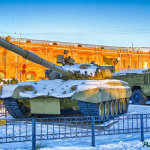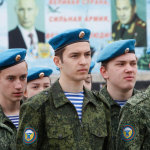The video of a Russian soldier executing a comrade is circulating on social media. To analyse what this execution means, we’ll examine another example.
On 30 January 1968 the Tet Offensive erupted. It proved a turning point in the Vietnam War. The decisive psychological blow to American public opinion was expressed in CBS anchor Walter Kronkite’s famous 27 February broadcast:
‘To say that we are closer to victory today is to believe, in the face of the evidence, the optimists who have been wrong in the past. To suggest we are on the edge of defeat is to yield to unreasonable pessimism. To say that we are mired in stalemate seems the only realistic, yet unsatisfactory, conclusion.
On the off chance that military and political analysts are right, in the next few months we must test the enemy’s intentions, in case this is indeed his last big gasp before negotiations. But it is increasingly clear to this reporter that the only rational way out then will be to negotiate, not as victors, but as an honourable people who lived up to their pledge to defend democracy and did the best they could.’
No image contributed more to the growing sense of repulsion over America’s commitment to South Vietnam than the street execution of a captured Viet Cong fighter: Nguyễn Văn Lém.

The event took place on 1 February in a panic-gripped Saigon. Hanoi’s hope of a popular uprising had failed spectacularly but Viet Cong gangs roamed the streets. Associated Press photographer Eddie Adams had spent a fruitless morning with an NBC journalist and Vietnamese camera crew looking for action. They were in the vicinity of the Ấn Quang Pagoda in downtown Saigon and preparing to leave when they noticed a commotion.
A captured Viet Cong in plaid shirt and shorts was being manhandled by a group of marines. His hands were cuffed behind his back. The unfortunate Lém was brought to police chief Nguyễn Ngọc Loan. In Adam’s words:
‘When they were close – maybe five feet away – the soldiers stopped and backed away. I saw a man walk into my camera viewfinder from the left. He took a pistol out of his holster and raised it. I had no idea he would shoot. It was common to hold a pistol to the head of prisoners during questioning. So I prepared to make that picture – the threat, the interrogation. But it didn’t happen. The man just pulled a pistol out of his holster, raised it to the VC’s head and shot him in the temple. I made a picture at the same time.’
Lém collapsed, a jet of blood spouting from his skull. It was all so matter-of-fact and quick.
Adams at first tried to pass off the importance of the photograph. It was just some guy shooting another guy. But it was so much more than that. Americans wanted to believe they were fighting a just cause. Loan’s revolver blew away that illusion.
Loan ended his days as a one-legged pizzeria manager in Virginia, passing away at a relatively young age from cancer. President Jimmy Carter personally intervened to stop his deportation (pressed by House of Representative members on the grounds he had committed a war crime). Adams grew to lament the photograph that won him the 1969 Pulitzer Prize for Spot News Photography: ‘Two people died in that photograph. The general killed the Viet Cong; I killed the general with my camera.’ Today there is an Italian furniture shop near the spot where Lém was killed.
Fifty-six years later…
Fifty-six years later, three Russian soldiers were jogging on a dirt track near Robotyne in occupied Zaporizhzhia. They were spaced apart, maintaining a short distance between each other. Only the first and last soldiers were armed. Unbeknown to the trio, a Ukrainian FPV drone pilot had them in his sights. He decided to attack the unarmed soldier in the middle.
This author has viewed scores of these YouTube videos. If the drone strikes the body it splits open the torso like a carcass in a butcher’s shop. Heads fly off. If the warhead detonates near the limbs, one or both legs are ripped off. Or limbs are left in impossible angles, like a broken doll. Some wounded make no movement at all. Some are evidently conscious but totally dazed and not apparently aware of their maiming. Many burn to death.
However, this soldier was lucky. At the last moment he heard the approach of the drone, raised his arms to protect his face, and quickened his run. The drone struck about ten feet behind him raising a great cloud of dust and leaving a small crater. The blast was sufficient to knock him over. He may have received some shrapnel in the back of his right leg.
The soldier checked himself then began shaking uncontrollably. This author has also seen this reaction many times. In some videos the wounded soldier can be seen screaming hysterically and violently shaking both arms.
In this case, the shaking did not last long. The third soldier walked up to the wounded soldier, aimed his rifle at the man’s head, and pulled the trigger. The victim seemed to know what was about to happen and turned his head. It was, like the execution of Lém, matter-of-fact and over in a second. The executioner then walked calmly on and did not bother to look back. The first soldier had run on.

Unlike the Vietnam War execution it seems unlikely we will ever know the identity of the executioner or the victim. There seems to be a story here: why was the soldier in the middle unarmed? Was he a refusenik? Was he being escorted back to company lines to receive disciplinary punishment?
It is also unlikely the execution of the unknown Russian soldier by a fellow soldier will have any effect on the war. The moral poverty of the Russian Army was displayed from the first month of the war. It has only deepened. Putin boasts that Russia is a great ‘civilisational-country’. He presumes to offer an alternative leadership to the Global South. He claims the world is turning its back on an evil ‘collective West’.
The execution video disproves him.
Cover photo: Censor.net
Sergio Miller
Sergio Miller is a retired British Army Intelligence Corps officer. He was a regular contributor and book reviewer forBritish Army Review. He is the author of a two-part history of the Vietnam War (Osprey/Bloomsbury) and is currently drafting a history of the Russian invasion of Ukraine.





